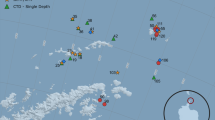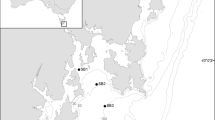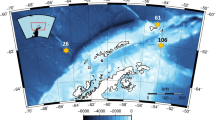Abstract
Salp grazing is important in sha** planktonic food-web structure. However, little is known about the size ranges of their prey in the field or how grazing impacts size structure. This study investigated the feeding habits of seven different species of salps, representing a variety of sizes and life stages across subtropical and subantarctic waters east of New Zealand. Scanning electron microscopy was used to examine the gut contents of 58 salps, which were then compared to water column plankton communities characterized via epifluorescence microscopy, FlowCam, and flow cytometry. While most of the gut contents resembled ambient waters, substantial differences were found amongst some co-occurring species, such as increased retention of submicron bacteria amongst smaller salps like Thalia democratica. We found that even for those salps capable of feeding on bacteria efficiently, nanoplankton and small microplankton still made up the majority of gut biomass. Larger microplankton were rarer in the guts than in the water column, potentially suggesting an upper size-threshold in addition to the lower size-threshold that has been the focus of most previous work. Salp carbon-weighted predator to prey size ratios were variable, with the majority falling between 1000:1 and 10,000:1 depending largely on the size of the salp. Taken together our results indicate that despite being able to feed on submicron particles, picoplankton make up at most 26.4% (mean = 6.4%) of salp gut carbon and are relatively unimportant to the energetics of most salps in this region compared to nanoplankton such as small dinoflagellates and diatoms.









Similar content being viewed by others
Data availability
All data is accessible on the Biological and Chemical Oceanography Data Management Office website (https://www.bco-dmo.org/project/754878).
Change history
20 May 2023
A Correction to this paper has been published: https://doi.org/10.1007/s00227-023-04233-0
References
Ahmad Ishak NH, Clementson LA, Eriksen RS, van den Enden RL, Williams GD, Swadling KM (2017) Gut contents and isotopic profiles of Salpa fusiformis and Thalia democratica. Mar Biol 164(6):144
Alldredge AL, Madin LP (1982) Pelagic tunicates: unique herbivores in the marine plankton. Bioscience 32(8):655–663
Anderson V (1998) Salp and pyrosomid blooms and their importance in biogeochemical cycles. In: Bone Q (ed) The biology of pelagic tunicates. Oxford University Press, pp 125–137
Barnes C, Maxwell D, Reuman DC, Jennings S (2010) Global patterns in predator–prey size relationships reveal size dependency of trophic transfer efficiency. Ecology 91(1):222–232. https://doi.org/10.1890/08-2061.1
Bathmann UV (1988) Mass occurrence of Salpa fusiformis in the spring of 1984 off Ireland : implications for sedimentation processes. Mar Biol 97:127–135
Berner LD (1967) Distributional atlas of Thaliacea in the California Current region. Calcofi Atlas No. 8, California Marine Research Committee
Bone Q (1998) The biology of pelagic tunicates. Oxford University Press
Bone Q, Braconnot JC, Ryan KP (1991) On the pharyngeal feeding filter of the salp Pegea confoederata (Tunicata: Thaliacea). Acta Zoologica 72(1):55–60
Bone Q, Carre C, Ryan KP (2000) The endostyle and the feeding filter in salps (Tunicata). J Mar Biol Assoc UK 80(3):523–534
Bone Q, Carre C, Chang P (2003) Tunicate feeding filters. J Mar Biol Assoc UK 83(5):907–919
Botes L, Price B, Waldron M, Pitcher GC (2002) A simple and rapid scanning electron microscope preparative technique for delicate “Gymnodinioid” dinoflagellates. Microsc Res Tech 59(2):128–130
Buitenhuis ET, Li WK, Vaulot D, Lomas MW, Landry MR, Partensky F, Karl DM, Ulloa O, Campbell L, Jacquet S, Lantoine F (2012) Picophytoplankton biomass distribution in the global ocean. Earth Syst Sci Data 4(1):37–46
Calbet A, Landry MR (2004) Phytoplankton growth, microzooplankton grazing, and carbon cycling in marine systems. Limnol Oceanogr 49(1):51–57
Cardona L, Álvarez de Quevedo I, Borrell A, Aguilar A (2012) Massive consumption of gelatinous plankton by Mediterranean apex predators. PLoS One 7(3):e31329
Caron DA, Madin LP, Cole JJ (1989) Composition and degradation of salp fecal pellets: implications for vertical flux in oceanic environments. J Mar Res 47(4):829–850
Chisholm SW (1992) Phytoplankton size. In: Falkowski PG, Woodhead AD (eds) Primary productivity and biogeochemical cycles in the sea. Plenum Press, New York, pp 213–237
Choi JW, Stoecker DK (1989) Effects of fixation on cell volume of marine planktonic protozoa. Appl Environ Microbiol 55(7):1761–1765
Conley KR, Lombard F, Sutherland KR (2018) Mammoth grazers on the ocean’s minuteness: a review of selective feeding using mucous meshes. Proc R Soc B. https://doi.org/10.1098/rspb.2018.0056
Crocker KM, Alldredge AL, Steinberg DK (1991) Feeding rates of the doliolid, Dolioletta gegenbauri, on diatoms and bacteria. J Plankton Res 13(1):77–82
Currie KI, Hunter KA (1998) Surface water carbon dioxide in the waters associated with the subtropical convergence, East of New Zealand. Deep Sea Res Part I 45(10):1765–77. https://doi.org/10.1016/S0967-0637(98)00041-7
Dadon-Pilosof A, Lombard F, Genin A, Sutherland KR, Yahel G (2019) Prey taxonomy rather than size determines salp diets. Limnol Oceanogr 64(5):1996–2010
Décima M, Stukel MR, López-López L, Landry MR (2019) The unique ecological role of pyrosomes in the Eastern Tropical Pacific. Limnol Oceanogr 64(2):728–743
Décima M, Stukel MR, Nodder SD, Gutiérrez-Rodríguez A, Selph KE, Dos Santos AL, Pinkerton M (2023) Salp blooms drive strong increases in passive carbon export in the Southern Ocean. Nat Commun 14(1):425
Deibel D, Lowen B (2012) A review of the life cycles and life-history adaptations of pelagic tunicates to environmental conditions. ICES J Mar Sci 69(3):358–369
Fenchel T (1987) Ecology of Protozoa: the biology of free-living phagotropic protists. Springer-Verlag
Forman JS, Horn PL, Stevens DW (2016) Diets of deepwater oreos (Oreosomatidae) and orange roughy Hoplostethus atlanticus. J Fish Biol 88:2275–2302
Foxton P (1966) The distribution and life history of Salpa thompsoni Foxton with observations on a related species, Salpa gerlachei Foxton. Discovery Rep 34:1–116
Frischer ME et al (2021) Selective feeding and linkages to the microbial food web by the doliolid Dolioletta gegenbauri. Limnol Oceanogr 66:1993–2010
Fuchs HL, Franks PJ (2010) Plankton community properties determined by nutrients and size-selective feeding. Mar Ecol Prog Ser 413:1–15
Garrison DL, Gowing MM, Hughes MP, Campbell L, Caron DA, Dennett MR et al (2000) Microbial food web structure in the Arabian Sea: a US JGOFS study. Deep Sea Res Part II 47(7–8):1387–1422
Greer AT et al (2020) Contrasting fine-scale distributional patterns of zooplankton driven by the formation of a diatom-dominated thin layer. Limnol Oceanogr 65:2236–2258
Hansen B, Bjornsen PK, Hansen PJ (1994) The size ratio between planktonic predators and their prey. Limnol Oceanogr 39(2):395–403. https://doi.org/10.4319/lo.1994.39.2.0395
Harbison GR, Gilmer RW (1976) The feeding rates of the pelagic tunicate Pegea confederata and two other salps 1. Limnol Oceanogr 21(4):517–528
Harbison GR, McAlister VL (1979) The filter-feeding rates and particle retention efficiencies of three species of Cyclosalpa (Tunicata, Thaliacea) 1. Limnol Oceanogr 24(5):875–892
Harbison GR, McAlister VL, Gilmer RW (1986) The response of the salp, Pegea confoederata, to high levels of particulate material: starvation in the midst of plenty 1. Limnol Oceanogr 31(2):371–382
Heath RA (1985) A review of the physical oceanography of the seas around New Zealand—1982. NZ J Mar Freshwat Res 19:79–124
Henschke N, Everett JD, Richardson AJ, Suthers IM (2016) Rethinking the role of salps in the ocean. Trends Ecol Evol 31(9):720–733
Horn PL, Burrell T, Connell A, Dunn MR (2011) A comparison of the diets of silver (Seriolella punctata) and white (Seriolella caerulea) warehou. Mar Biol Res 7:576–591
Jennings S, Warr KJ, Mackinson S (2002) Use of size-based production and stable isotope analyses to predict trophic transfer efficiencies and predator-prey body mass ratios in food webs. Mar Ecol Prog Ser 240:11–20
Jung SW, Joo HM, Park JS, Lee JH (2010) Development of a rapid and effective method for preparing delicate dinoflagellates for scanning electron microscopy. J Appl Phycol 22(3):313–317
Katechakis A, Stibor H (2004) Feeding selectivities of the marine cladocerans Penilia avirostris, Podon intermedius and Evadne nordmanni. Mar Biol 145(3):529–539
Koon MA, Ali KA, Speaker RM, McGrath JP, Linton EW, Steinhilb ML (2019) Preparation of prokaryotic and eukaryotic organisms using chemical drying for morphological analysis in scanning electron microscopy (SEM). J Vis Exp 143:e58761
Kremer P, Madin LP (1992) Particle retention efficiency of salps. J Plankton Res 14(7):1009–1015
Landry MR, Ohman MD, Goericke R, Stukel MR, Tsyrklevich K (2009) Lagrangian studies of phytoplankton growth and grazing relationships in a coastal upwelling ecosystem off Southern California. Prog Oceanogr 83(1–4):208–216
Lindeman RL (1942) The trophic-dynamic aspect of ecology. Ecology 23(4):399–417
Lüskow F, Pakhomov EA, Stukel MR, Décima M (2020) Biology of Salpa thompsoni at the Chatham Rise, New Zealand: demography, growth, and diel vertical migration. Mar Biol 167(12):1–18
Madin LP (1974) Field observations on the feeding behavior of salps (Tunicata: Thaliacea). Mar Biol 25(2):143–147
Madin LP (1982) Production, composition and sedimentation of salp fecal pellets in oceanic waters. Mar Biol 67(1):39–45
Madin LP, Kremer P (1995) Determination of the filter-feeding rates of salps (Tunicata, Thaliacea). ICES J Mar Sci 52(3–4):583–595
Madin LP, Purcell JE (1992) Feeding, metabolism, and growth of Cyclosalpa bakeri in the subarctic Pacific. Limnol Oceanogr 37(6):1236–1251
Madin LP et al (2006) Periodic swarms of the salp Salpa aspera in the slope water off the NE United States: biovolume, vertical migration, grazing, and vertical flux. Deep Sea Res Part I 53:804–819
Menden-Deuer S, Lessard EJ (2000) Carbon to volume relationships for dinoflagellates, diatoms, and other protist plankton. Limnol Oceanogr 45(3):569–579
Metfies K, Nicolaus A, Harbou LV, Bathmann U, Peeken I (2014) Molecular analyses of gut contents: elucidating the feeding of co-occurring salps in the Lazarev Sea from a different perspective. Antarct Sci 26(5):545–553
Mianzan H et al (2001) Feeding on survival-food: gelatinous plankton as a source of food for anchovies. Hydrobiologia 451:45–53
Michaels AF, Silver MW (1988) Primary production, sinking fluxes and the microbial food web. Deep-Sea Res 35(4):473–490
Mullin MM (1983) In situ measurement of filtering rates of the salp, Thalia democratica, on phytoplankton and bacteria. J Plankton Res 5(2):279–288
Naustvoll LJ (2000) Prey size spectra and food preferences in thecate heterotrophic dinoflagellates. Phycologia 39(3):187–198
Nishikawa J, Tsuda A (2001) Feeding of the pelagic tunicate, Salpa thompsoni, on flagellates and size-fractionated chlorophyll particles. Plank Biol Ecol 48(2):133–135
Nishimura S (1958) Quelques remarques sur l’Ingestion du Salpe, Salpa fusiformis Cuvier, chez les Marquereaux Pêchés dans la Mer du Japan Orientale. Ann Rept Jap Sea Reg Fish Res Lab 4:105–112
Nodder SD, Chiswell SM, Northcote LC (2016) Annual cycles of deep-ocean biogeochemical export fluxes in subtropical and subantarctic waters, southwest Pacific Ocean. J Geophys Res Oceans 121(4):2405–2424
Pauli N, Metfies K, Pakhomov EA, Neuhaus S, Graeve M, Wenta P, Flintrop CM, Badewien TH, Iversen MH, Meyer B (2021) Selective feeding in southern ocean key grazers—diet composition of krill and salps. Commun Biol 4(1):1061. https://doi.org/10.1038/s42003-021-02581-5
Perissinotto R, Pakhomov EA (1998) Contribution of salps to carbon flux of marginal ice zone of the Lazarev Sea, Southern Ocean. Mar Biol 131(1):25–32
Purcell JE (1981) Dietary composition and diel feeding patterns of epipelagic siphonophores. Mar Biol 65:83–90
Putt M, Stoecker DK (1989) An experimentally determined carbon: volume ratio for marine “oligotrichous” ciliates from estuarine and coastal waters. Limnol Oceanogr 34(6):1097–1103
Selph KE (2021) Enumeration of marine microbial organisms by flow cytometry using near-UV excitation of Hoechst 34580-stained DNA. Limnol Oceanogr Methods 19(10):692–701
Sheldon RW, Sutcliffe WH Jr, Paranjape MA (1977) Structure of pelagic food chain and relationship between plankton and fish production. J Fish Bd Can 34(12):2344–2353
Sherr E, Sherr B (1988) Role of microbes in pelagic food webs: a revised concept. Limnol Oceanogr 33(5):1225–1227
Sherr EB, Sherr BF (2002) Significance of predation by protists in aquatic microbial food webs. Antonie Leeuwenhoek Int J General Mol Microbiol 81(1–4):293–308
Sherr EB, Sherr BF, McDaniel J (1991) Clearance rates of < 6 μm fluorescently labeled algae (FLA) by estuarine protozoa: potential grazing impact of flagellates and ciliates. Mar Ecol-Prog Ser 69(1–2):81–92
Sieracki CK, Sieracki ME, Yentsch CS (1998) An imaging-in-flow system for automated analysis of marine microplankton. Mar Ecol Prog Ser 168:285–296
Silver MW (1975) The habitat of Salpa fusiformis in the California current as defined by indicator assemblages 1. Limnol Oceanogr 20(2):230–237
Silver MW, Bruland KW (1981) Differential feeding and fecal pellet composition of salps and pteropods, and the possible origin of the deep-water flora and olive-green “cells.” Mar Biol 62(4):263–273
Sokolov S, Rintoul SR (2009) Circumpolar structure and distribution of the antarctic circumpolar current fronts: 1. Mean circumpolar paths. J Geophys Res Oceans 114(11):1–19. https://doi.org/10.1029/2008JC005108
Stukel MR, Biard T, Krause J, Ohman MD (2018) Large Phaeodaria in the twilight zone: their role in the carbon cycle. Limnol Oceanogr 63(6):2579–2594
Stukel MR, Décima M, Selph KE, Gutiérrez-Rodríguez A (2021) Size-specific grazing and competitive interactions between large salps and protistan grazers. Limnol Oceanogr 66(6):2521–2534
Sutherland KR, Madin LP (2010) A comparison of filtration rates among pelagic tunicates using kinematic measurements. Mar Biol 157(4):755–764
Sutton PJ (2003) The Southland current: a subantarctic current. NZ J Mar Freshwat Res 37(3):645–652
Takahashi K, Ichikawa T, Fukugama C, Yamane M, Kakehi S, Okazaki Y, Furuya K (2015) In situ observations of a doliolid bloom in a warm water filament using a video plankton recorder: bloom development, fate, and effect on biogeochemical cycles and planktonic food webs. Limnol Oceanogr 60(5):1763–1780
Tanimura A, Kawaguchi S, Oka N, Nishikawa J, Toczko S, Takahashi KT et al (2008) Abundance and grazing impacts of krill, salps and copepods along the 140^ oE meridian in the Southern Ocean during summer. Antarct Sci 20(4):365
Taylor AG, Landry MR, Selph KE, Yang EJ (2011) Biomass, size structure and depth distributions of the microbial community in the eastern equatorial Pacific. Deep Sea Res Part II 58(3–4):342–357
Taylor AG, Landry MR, Selph KE, Wokuluk JJ (2015) Temporal and spatial patterns of microbial community biomass and composition in the Southern California current ecosystem. Deep Sea Res Part II 112:117–128
Thompson AW, Sweeney CP, Sutherland KR (2023) Selective and differential feeding on marine prokaryotes by mucous mesh feeders. Environ Microbiol. https://doi.org/10.1111/1462-2920.16334
Vargas CA, Madin LP (2004) Zooplankton feeding ecology: clearance and ingestion rates of the salps Thalia democratica, Cyclosalpa affinis and Salpa cylindrica on naturally occurring particles in the Mid-Atlantic Bight. J Plankton Res 26(7):827–833
von Harbou L, Dubischar CD, Pakhomov EA, Hunt BP, Hagen W, Bathmann UV (2011) Salps in the Lazarev Sea, Southern Ocean: I. Feeding dynamics. Mar Biol 158(9):2009–2026
Walters TL, Lamboley LM, López-Figueroa NB, Rodríguez-Santiago ÁE, Gibson DM, Frischer ME (2019) Diet and trophic interactions of a circumglobally significant gelatinous marine zooplankter, Dolioletta gegenbauri (Uljanin, 1884. Mol Ecol 28(2):176–189
Zentara SJ, Kamykowski D (1981) Geographic variations in the relationship between silicic acid and nitrate in the South Pacific Ocean. Deep Sea Res Part A 28(5):455–465. https://doi.org/10.1016/0198-0149(81)90137-0
Zinabu GM, Bott TL (2000) The effects of formalin and Lugol’s iodine solution on protozoal cell volume. Limnol-Ecol Manag Inland Waters 30(1):59–63
Acknowledgements
We would like to thank the captain and crew of the R/V Tangaroa for help in the deployment of equipment as well as our many collaborators in the SalpPOOP project including Scott Nodder, Sadie Mills, Florian Lüskow, Morgan Meyers, Sarah Searson, Lana Young, Siobhan O’Connor, Karl Safi, Adriana Lopes dos Santos, and Fenella Deans.
Funding
This study was made possible by funding from the Ministry for Business, Innovation and Employment (MBIE) of New Zealand, NIWA Coast and Oceans Food Webs (COES) and Ocean Flows (COOF), and the Royal Society of New Zealand Marsden Fast-track award to M. Décima, and by U.S. National Science Foundation awards OCE- 1756610 and 1756465 to M.R.S. and K.E.S.
Author information
Authors and Affiliations
Contributions
CKF and MRS wrote the manuscript and conducted the data analysis. MD was responsible for cruise planning and locating salps. KS conducted FlowCam and flow cytometry sampling. NY conducted epifluorescence microscopy sampling and image analysis. MD and CKF were responsible for net deployments and sample collection. CKF was responsible for SEM and FlowCam image analysis. All authors contributed to editing the manuscript.
Corresponding author
Ethics declarations
Conflict of interest
The authors declared no conflict of interests.
Ethical approval
All applicable international, national, and/or institutional guidelines for sampling and experimental use of organisms for the study have been followed and all necessary approvals have been obtained.
Additional information
Responsible Editor: X. Irigoien .
Publisher's Note
Springer Nature remains neutral with regard to jurisdictional claims in published maps and institutional affiliations.
The original online version of this article was revised: In this article Figure 3 has been corrected.
Supplementary Information
Below is the link to the electronic supplementary material.
Rights and permissions
About this article
Cite this article
Fender, C.K., Décima, M., Gutiérrez-Rodríguez, A. et al. Prey size spectra and predator to prey size ratios of southern ocean salps. Mar Biol 170, 40 (2023). https://doi.org/10.1007/s00227-023-04187-3
Received:
Accepted:
Published:
DOI: https://doi.org/10.1007/s00227-023-04187-3




